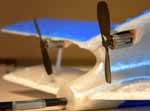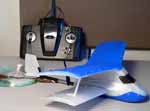Concorde
Art Hobby Sky
Terry
2.0 1.1 1.0
Seeker
Wild Thing
Koleos-E
Aero Ace
All planes…
![]() Aero Ace
Aero Ace
![]()
 Yup, it actually flies |
 Cute widdle pwopellers |
 With CD for scale |
|
Air Hogs' Aero Ace.
Specifications22 cm span. 23.5 cm long. 19 g. 38 sq.in.
Thrust: full power climb 12 g, cruise about 6 g.
The Aero Ace is a li-poly twin-motor differential thrust RTF airplane. It has no moving control surfaces, though the tail feathers can be trimmed like a dime-store balsa glider's. It recharges from the transmitter's 6 AA cells in about 30 minutes. If it takes you two minutes to open the box, that means 32 minutes later you can start a ten-minute flight. I find that NiMH AA's work as well as alkalines. It costs $25 to $30. The manufacturer is Spin Master, 1-800-622-8339.
Purpose(This text is a minor revision of the lead article in the Dec. 2005 Ampeer.)A friend accuses me of ritually burning my models' assembly manuals. So I bought this as a challenge to not spend a hundred bucks and a hundred hours upgrading an airplane with the same price, weight, and setup time as a servo. This RTF model is not amenable to precise numerical analysis. If you really want to know its cubic wing loading, pitch speed, and airfoil camber, then you won't be modifying it to increase performance. You'll throw out the airframe and build a proper one from scratch. But as an aeromodeler you'd be wrong to "improve" this airplane. This model is a powerful evangelizer for our hobby. More people see me fly this in my office lobby, parking lot, and driveway than ever hear my hotliner's whistling low passes. And John Doe gets really interested -- pulls out pen and paper -- after he's seen it recover from a dozen impacts and when I tell him it costs him 25 bucks plus 2 minutes. When our security guard investigated the odd phasing-twin sound in the lobby, far from shooing me away, she actually insisted on launching it for me. And John Doe's children chase it around the park because it's soooo cute. With big googly eyes and a soft pelt, they would cuddle up with it at night. And it would fly fine the next day after wiping off the drool.
ConstructionEPP foam pod and wings. Drinking-straw boom. Tail feathers 0.5 mm foam. Decorative plastic(!) heat sinks on the motors. Tiny charge jack and on/off switch under the pod. As indestructible as a tennis ball, because of the EPP and light weight.My model's EPP interplane struts unglued after a few flights. It flew fine without them but looked weird. All right, weirder. In the photos here, I've replaced them with thin drinking straws cut to length and CA'd in place. ControlsThe left stick controls throttle, the right controls differential thrust. Ease off from full throttle to increase the differential if you need to turn more sharply. Play the throttle to reduce porpoising. When you cut throttle, you lose all turning control and glide like a crumpled paper ball.FlyingFirst, set the steering trim with the little knob on the transmitter. As a first guess, twiddle the knob until both motors hum at the same pitch.The Aero Ace doesn't have enough thrust to rise off ground, even from freshly waxed terrazo. (Some have reported success with Matchbox-car wheels.) Hand-launch any way you like: technique is irrelevant. Even from a spinning frisbee launch it eventually recovers. Indoor flight initially requires an unobstructed space the size of a basketball court. For a pilot used to 72 MHz responsiveness, it takes time to adapt to the 0.15 second lag between moving the sticks and hearing the motor whine change. It feels more like remote suggestion than remote control. Outdoors, it does best in winds under 3 mph. Since it has such low mass and low airspeed, gusts and micro-thermals lift it frighteningly. Within two seconds it can leap up 20 feet. Cruising 60 feet high, trying not to lose it to a tree or roof, is in its way as exciting as working a thermal far downwind in a glider worth a hundred times as much. Outdoors, the humming motors attract dragonflies and even hummingbirds. (Indoors, they attract security guards. Conclude what you will.) It's more typical to fly low and bash it around, classic foamie abuse but with even fewer consequences. Circling my waist, it feels more like a pet than an airplane. Combat with other Aero Aces is fun but difficult, because of the mushy controls. Planetary collisions are far more common than the mid-air kind. Radio range is entirely adequate: no glitching even a hundred feet out. At that distance the airplane's hardly visible and, if downwind, it may take 5 minutes to reach you again. Inverted flight, loops, and rolls are impossible. At least you can't command them. You can only wait for a gust and then claim you intended that wild maneuver. Three feet of videotape scotchtaped to the forward end of the boom damps its porpoising (pitch instability), and glistens prettily in flight. Multiple cassette tape streamers work too, but they snarl the propellors in wilder crashes. As the battery fades (reportedly 130 mAh), the clear symptom is refusal to climb. It just hums along a few feet above the ground. I expected the Aero Ace to be an amusing one-hour diversion before I got bored and returned to aerobats and sailplanes. But, like disposable cameras, it fills a niche nobody expected. It's plain fun to fly this jalopy, and it attracts attention which sticks. So I expect it to endure as long as disposable cameras, too. Particularly since the only practical way to hurt it is with repeated low passes over an enraged kittycat. Google postscript, 2006 Oct 10A former student in my lab now works at Google. Aero Aces are popular there because the buildings shield you from the ocean breezes. He watched turbulence coming over a building grab a friend's Aero Ace and plop it on the roof. They sheepishly went to get it retrieved. Security: "Oh, there's another plane on the roof. I'll be right back."Googlefolk also joust: launch two at each other from 30 feet apart, get a point for scoring a hit, lose a half point for landing. Neighborly postscript, 2008 Mar 29My neighbor's six-year-old is hooked. |
|||